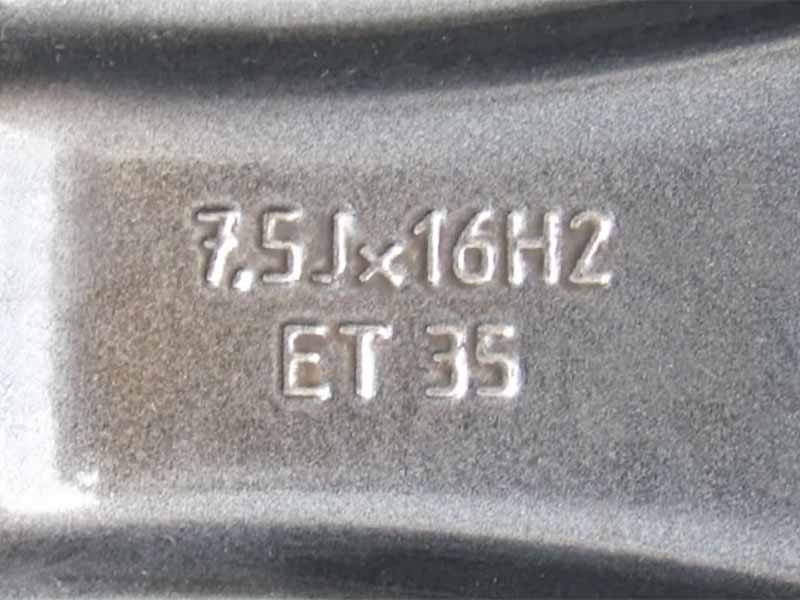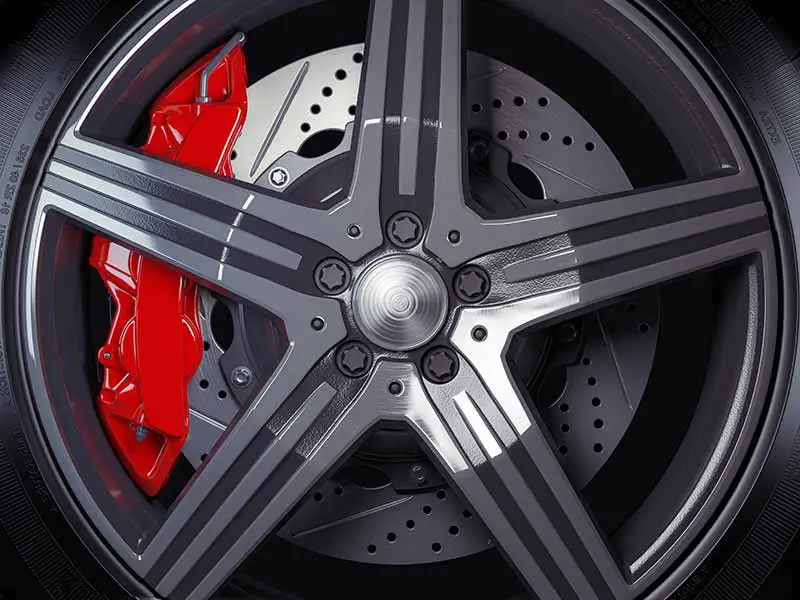Tire size consist of several measurements. One of the 3 most important measurements is the diameter of the wheel.
Along with section width and aspect ratio, these 3 measurements can allow you to know a lot about the size of your tires and wheels and give you a better understanding of their performance.
Wheel Diameter
The wheel diameter is the height of the rim barrel of your wheel from the tire bead seat at the top to the tire bead seat at the bottom.
This measurement is in inches and can be found on tire sizes to ensure a proper fit as well as on the wheel itself.
Understanding wheel sizes can help you with purchasing new wheels or simply keeping your wheels the same size but switching to slightly different tire sizes.
Let’s take a closer look.
How To Know What Size Wheels You Have
The easiest way to determine your wheel size is from the tire that’s currently mounted onto the wheel.
The tire size is usually molded into the sidewall of the tire and will look something like:
P 235/45 R18 95 V
You can read our article on how to read tire sizes if you want a complete breakdown, but we’re just going to focus on the rim diameter of the wheel.
In the example above you will see the number “18” following the letter “R”. This is the wheel diameter in inches.
Where To Find Wheel Size

The factory wheel size for your car or truck can be found in your owner’s manual or on a sticker in the driver’s door jam.
If you don’t have tires currently mounted on your wheels you can usually find the wheel size listed on the back of the wheel or etched into the barrel. You can see an example of the size cast into the back of a spoke by a wheel manufacturer in the image below:
This is helpful to know when you have aftermarket wheels without tires mounted and they are not the same wheel size as the OEM wheels.
Reading Rim Size And Other Wheel Dimensions
Wheel markings can look confusing, but we’ll break them down so you know what each represents. We’ll take the image above as our example and explain each segment:
7,5Jx16H2 ET 35
- 7,5 – Represents the width of the rim in inches. European measurements use commas instead of decimals. US-specific measurements would look like 7.5.
- J – Represents the rim flange contour
- 16 – Represents the diameter of the rim in inches.
- H2 – Represents the hump design across the barrel of the rim
- ET 35 – Represents the offset of the wheel from the hub mounting surface
How To Measure Rim Diameter
The rim size is not measured from the furthest point at the top of the wheel to the bottom. It’s actually measured from the bead seat at the top to the one at the bottom.
This will require estimating a bit whether you have tires mounted on your wheels or not. If you have tires mounted, you won’t actually be able to see where the bead would come into contact with the rim. If you don’t have tires mounted, you’ll be able to see inside the wheel lip, but you won’t be able to place a tape measure at the spot to get a precise measurement.
Fortunately, wheel diameters are almost always in whole inches. So, 18″ or 19″ and not 18.375″ or some other whole number in inches.
There are some wheels that come in half sizes but these are unusual. Here are the rare half inch increment wheel sizes:
- 16.5″
- 17.5″
- 19.5″
- 22.5″
Changing Tire Size On The Same Rim
While you can’t mount a tire meant for a 19″ wheel on an 18″ wheel, you can increase or decrease the ideal width of the tire somewhat. A wider tire will improve traction and handling while a narrower tire will improve fuel economy.
How Much Difference In Tire Size Is Acceptable?
There is usually the ability to adjust 15-20mm of width more or less from the ideal size. This may seem like an fairly insignificant difference, but a small difference can have noticeable changes in handling or fuel economy.
Effects Of Changing Tire Size
Tire diameter will change with the width of the tire because the sidewall height is a percentage of the tire width. For instance, let’s calculate the sidewall height in millimeters of a tire width of 235 with an aspect ratio of 45.
235 x .45 = 105.75mm
Now let’s calculate the sidewall height if you were to increase the width to 245 with an aspect ratio of 45.
245 x .45 = 110.25mm
Changing width will also affect the overall diameter of your tires which will affect your speedometer accuracy. The amount will be fairly insignificant but it worth pointing out.
Parts Of A Wheel On A Car
Lip
The lip of a wheel can be described as the overhang of the rim beyond the face of the wheel. Larger lip wheels reduce clearance for brake components but many prefer deeper lips for the looks.
Barrel
The barrel of a wheel is essentially the body of the wheel that spans the width from the inner and outer edge of the rim.
Spoke
Spokes are the supporting elements that span from the lug nuts and wheel studs to the barrel of the wheel.
Lug Holes
The lug holes are where the wheel studs and and lug nuts connect through to secure the wheel to the mounting surface.
Center Bore
The center bore is a machined circular recess or opening in the back of the wheel’s mounting surface in the center point of the bolt pattern. The center bore mates to a hub centric ring that centers the wheels to the hub mounting surface to reduce the potential for wobble and vibrations.
Rim
While we commonly refer to wheels as rims as well, the truth is the rim is only a part of the wheel. The rim is actually the vertical face of the inner and outer wheel lips.
Valve Stem
The valve stem isn’t actually part of the wheel but the wheel must contain an opening for the valve stem to protrude.
The valve stem seals around the opening in the wheel, and as you might have guessed, it allows air pressure to be added to the wheel assembly.
Rims Vs Wheels
Even though it’s common to refer to wheels as rims, the rim is just a part of the overall wheel. The rims of a wheel are the outside edge of the lip.
Wheels are the entire combination of parts that make up the part the tire mounts onto and mounts to the hub that either has lug studs or allows lug nuts to be screwed into it to secure the wheel to the vehicle’s suspension.
Rims Vs Hubcaps
Most vehicles these either have premium alloy wheels or inexpensive steel wheels with hubcaps to make the steel wheels look more attractive.
Hubcaps typically snap on overtop of the entire face of the steel wheel. Originally, hubcaps literally were only meant as a protective cover the hub section and not a decorative covering for the entire wheel. This is still common on heavy and light trucks but very rare on todays coupes and sedans.
How To Calculate Tire Height And Circumference
Tire height is equal to the wheel diameter plus twice the section height. Section height is measured as a percentage of section width. Section width and section height are both listed on the sidewall of all tires.
The tire height can be found with only the section width, section height, and wheel diameter.
Tire Diameter (Height) And Circumference Calculator
Input the 3 primary tire size measurements to convert Section Height to millimeters, calculate Wheel & Tire Diameter (mm & in), and calculate Tire Circumference (mm & in).
Resources
Below are some links you may find helpful when learning about tires
Final Thoughts
Wheel diameter is one of the three main measurements used in determining tire sizes. Knowing the rim size, section width, and aspect ratio are keys to knowing what tires will fit your car or truck.
Wheel diameter is a part of the tire size molded into the sidewall of every tire. It is also usually cast into the backside of a wheel spoke or etched into the barrel.
You can also simply measure the rim size. The diameter isn’t measured from the outer edge of the rim but from the bead seat behind the rim.
No mater whether you’re sticking with your OEM wheels and changing to slightly smaller tires or larger tires, or buying new wheels and need to adjust the aspect ratio of your new tires to match your vehicle’s factory rolling diameter.
Understanding how the diameter of your wheels affects overall diameter and tire size is important to your vehicle’s suspension components and performance.
Good luck and happy motoring.




